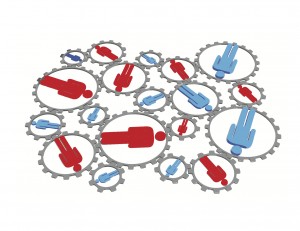Facebook Vs. Face Time
My parents do not have a microwave, cordless phone, Interac card, email account, or computer. They know only that Google, Facebook, Twitter, and LinkedIn are Internet features. Their lack of social media connectivity would challenge most of us. Certainly, I used to find it surprising that they could function without all these handy tools, but I have come to appreciate the simplicity of their choices. My parents’ lives and my own experience have led me to explore whether there is a qualitative difference between Facebook and face time.
Is there a hidden cost to our reliance upon technology-driven communication?
In “Well Connected?: The Biological Implications of ‘Social Networking’” (Biologist, Feb. 2009, vol. 56, no. 1, pp. 14–20), Aric Sigman claims that reduced direct social interaction is associated with particular physiological alterations and significant health risks. The journal’s press release summarizes the paper’s findings as follows:
Global alterations in human gene transcription, immune system cytokines and natural killer (NK) cells, narrowing of major arteries, incidence of stroke, early death, high blood pressure, dementia, Alzheimer’s, and even the common cold, can all be linked to changes in our social patterns.
Spooky stuff, but simply summarized: getting together face-to-face is a healthy activity and one not be taken lightly. Sigman has identified a dramatic decline since 1987 in hours per day of face-to-face social interaction in Britain as the use of electronic media dramatically increased.
As a health professional, I see the full range of negative health effects of life behind the keyboard. We know that one in four will suffer from a depressive episode in their lifetime, but very few will seek treatment. For organizations, the highest healthcare costs result from mental health claims and medications to treat high cholesterol, blood pressure, and cardiovascular disease—all of which are strongly correlated with sedentary lifestyles and our lack of face-to-face interaction.
At the recent Torch Bearers’ Breakfast Series organized by the Vancouver Board of Trade, Janet Austin, CEO of YWCA Vancouver, spoke of her joy as friends from across Canada came to watch her run with the Olympic torch. Johnna Sparrow Crawford, Torchbearer Coordinator for the Musqueam Indian Band, described how the Olympic Games have spurred First Nations communities to connect more closely than ever before with their neighbors from across Canada and the world.
Darcy Rezac, Managing Director and Chief Engagement Officer of the Vancouver Board of Trade, is an old hand at face-to-face networking. Telling of his experiences during the 2010 Olympic Games, he recalled Sidney Crosby’s goal that won Canada gold for men’s hockey and the feats of the speed skaters at the Richmond Oval. He ran into a friend downtown. Out of the blue, his friend just took off his “Canada” scarf and put it around Darcy’s neck. At the Oval, a little boy came up to Darcy and said, “Hey Mister! Would you like to trade an Olympic pin with me?” “I certainly can” was his reply and a small bond was forged and a treasured memory captured. What made his—and our—experience of the Olympics so memorable is precisely that we shared it in person with our friends and with others in our physical, not virtual, community.
Sure, social media provides great tools for staying in touch with distant friends and connecting with fun and informative online communities. Some argue that social media is the way of the future and its continued growth attests to the popularity. Realistically though, can this disembodied interaction possibly equal our face-to-face moments? Many of us are now better acquainted with our Facebook friends than our next-door neighbors. Is there a cause–effect relationship there? Is time spent on social media subtracted from time spent face-to-face with people?
I confess that Facebook has a place in my life and the lives of almost everyone I know. Before starting this article, I wasn’t imagining what negative health effects I might develop from such a strong reliance on social media. One personal example: it can have negative effects on concentration. As I was writing the first draft of this article, I jumped between windows at least five times to check my Facebook account.
Sigman observes, “Social connection, both objective and subjective, is increasingly associated with physiological changes known to influence morbidity and mortality . . . [but] the intricate mechanisms involved are only now being understood.”
And what does “keeping in touch” really mean? Am I adding real value to my life by browsing through a friend-of-a-friend’s pictures?
Warren Buffet observed in his book, The Snowball: Warren Buffet and the Business of Life, “When you get to my age, you’ll really measure your success in life by how many of the people you want to have love you actually do love you. … That’s the ultimate test of how you have lived your life.”
My parents’ example teaches me that cultivating such love and building community come from those innumerable little face-to-face interactions that bless our daily lives.
At the end of the day, I have concluded that, like many people, I spend far too much time interacting through social media such as Facebook. I have set a personal goal of cutting my Facebook time to 1.5 hours per week and devoting more time to face-to-face interaction, to regain a deeper sense of what it really means to be connected.
(PeopleTalk: Summer 2010)








